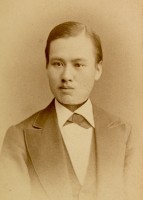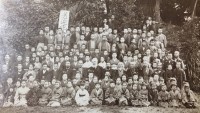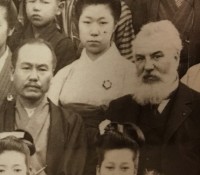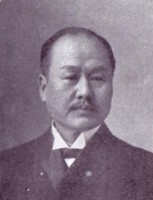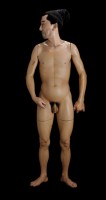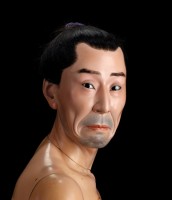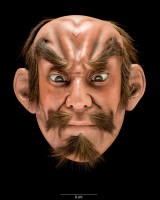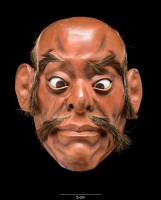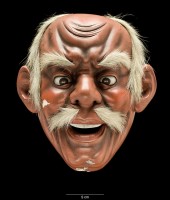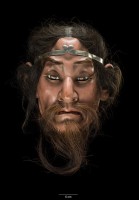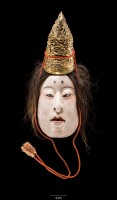The browser will either open the file, download it, or display a dialog.

The ethnological collections of the Smithsonian’s National Museum of Natural History (NMNH) contain approximately 9,100 Japanese objects, primarily from the late Tokugawa period (1603–1868) through the Showa era (1926–89). While aspects of the collection have been previously researched, including the materials amassed during Commodore Matthew Perry’s expedition to Japan (which was the first set of ethnological objects accessioned by the Smithsonian),[1] the masks presented for the first time here demonstrate that new discoveries await even within well-known legacy collections. This group of seven highly evocative masks was collected by famed inventor Alexander Graham Bell during his only journey to Japan, undertaken in 1898. In order to situate the collection historically and artistically, I outline Bell’s ties to Japan and to the Smithsonian before considering the nature and significance of the objects themselves. I conclude with a discussion of opportunities for further research on this rare and relatively unstudied art form.
Alexander Graham Bell and Japan
Alexander Graham Bell’s relationship with Japan can be traced to his time as professor of the mechanism of speech at Boston University from 1874 to 1879, during which he invented and was awarded the first US patent for the telephone.[2] Bell had a young Japanese student in Boston named Isawa Shūji (fig. 1), who had been sent to the US by the Japanese government to study the American education system under Bell and bring this knowledge back to Japan. Famously, Isawa used Bell’s telephone in 1877 to speak in Japanese with two of his friends from Japan who were studying at Harvard, marking the first time a language other than English was communicated over the device.[3] Isawa was himself a visionary in the field of education. After returning to Japan in 1878, he helped establish the Tokyo Normal School (now the University of Tsukuba) in 1879, the Tokyo School for the Deaf (now the Central School for the Deaf) in 1880, the Tokyo School of Music (now the Tokyo University of Arts) in 1887, as well as the public school system of Taiwan in 1895.[4]
Though they did not know it when Isawa returned to Japan in 1879, he and Bell were to be reunited many years later in Japan. Bell would also see Isawa’s two friends again, as he fondly recounted in a 1911 speech to the National Geographic Society:
The two Japanese gentlemen, students at Harvard, were exceptional men. I did not know at the time who they were, but years afterwards their names were revealed to me. I was in Japan, Yokohama, when the American Residents in Japan were giving a banquet to the new Japanese Minister who was going to Washington, Mr. Komura, now at the head of affairs in Japan. I was asked to attend the banquet, and instead of being introduced to Mr. Komura he came up to me and said, “I don’t require an introduction to Mr. Bell. I knew him years ago.” And he turned out to be one of the Japanese students. Then I found out about the other one in a rather curious way. The Japanese government sent to this country at the time of the Russian-Japanese War Baron Kaneko. He came to Washington and gave a lecture at the time and we entertained him at dinner. When the dinner was over and the time for speaking came, Baron Kaneko said, “I knew Mr. Bell years ago,” and he told his story about the use of the telephone. So these two men, the foremost men in Japan today . . . were the two men who heard the telephone in the winter of 1876–1877. (Applause.)[5]
Isawa’s Harvard friends, the “two Japanese gentleman” Bell refers to, were Komura Jutarō and Kaneko Kentarō. Both of these men went on to become senior Japanese political leaders who played crucial roles in the Russo-Japanese War of 1904–5. Although it is beyond the scope of this article, a fascinating series of letters from Kaneko, then Japanese special envoy to the United States, to President Theodore Roosevelt between 1904 and 1905 illustrates how Kaneko kept Roosevelt abreast of wartime events and actively sought Roosevelt’s assistance with ending the war with Russia.[6] Through these efforts, Roosevelt was eventually enlisted to broker the Treaty of Portsmouth that ended the war on September 5, 1905, for which he was awarded the Nobel Peace Prize in 1906. Interestingly, the Japanese signatory of the treaty was Minister of Foreign Affairs (and the other former Harvard student) Komura Jutarō. Also present at the signing of the treaty was Alexander Graham Bell,[7] who was there in his capacity as a Smithsonian Institution regent (I expand on this subject in the next section).[8]
More than two decades after working with Isawa in Boston, Bell wrote to his father on August 28, 1898, to convey his plans to travel to Japan for the first time later that year with his wife Mabel and their two daughters. He was evidently less than enthusiastic about the journey, writing, “Elsie and Daisy are anxious to travel this autumn and have planned out a trip to Japan and the Hawaian [sic] Islands . . . Neither Mabel nor I care much about going but we realize that our opportunities for travelling with our children grow less every year.”[9] Besides an eagerness to travel with his daughters, who were by then 18 and 20 years old and nearing the age at which they would be expected to leave the family home and enter society, Bell had other reasons to travel to Japan. As his fame had grown dramatically with the success of the telephone, he began to receive solicitations to speak from all over the globe, including an invitation from Emperor Meiji of Japan. This must surely have been an intriguing invitation, as Japan had only opened to the rest of the world a few decades earlier following what is now known as the Meiji Restoration of 1868.
One week after writing to his father, Bell and his family took the cross-country train from Washington, DC, to San Francisco, and on September 17 they boarded the SS Coptic bound for Yokohama. They arrived in Yokohama on October 5 and checked into the Grand Hotel. Bell accepted the emperor’s invitation, though this meeting did not leave a positive impression on him:
In Japan [Bell] got word that the emperor would receive him at ten in the morning . . . Thompson [Bell’s butler and friend] managed to rout [sic] Bell out of bed at what for him was an unearthly hour, get him out of bed, get him into his “horrid outfit,” and send him on his way. On his return Bell immediately went to bed without comment, woke at two in the afternoon, and asked when the consul was coming to take him to the emperor. After a while the details came back hazily to his mind. But he did not like what he recalled of the emperor’s exaggerated hauteur, traditional or not, and so he commented, “Well, I am glad I was not awake.”[10]
In addition to the emperor’s invitation, Bell would surely have been eager to visit the Tokyo School for the Deaf, founded by Isawa Shūji in 1880 (which had become the Tokyo School for the Deaf and Blind by 1898), as one of Bell’s great lifelong passions was the promotion of the welfare and education of the hearing disabled. Indeed, Bell was photographed at the school surrounded by a group of students and teachers on October 10, 1898 (fig. 2); a close examination of this photograph reveals Isawa Shūji seated on Bell’s immediate right (figs. 3, 4). This confirms that Bell was finally able to meet his friend and former student again after more than twenty years.
Beyond Bell’s meeting with the emperor and his visit to the School for the Deaf and Blind, the places visited and activities carried out by the Bell family during their trip can be pieced together from Bell’s and Elsie’s diaries, and related materials in the A. G. Bell Family Papers and Grosvenor Family Papers at the Library of Congress.[11] The Bell family toured several popular sites in the Kantō region, including the tomb of Tokugawa Ieyasu at Nikko and the hot spring resort area of Hakone, and met with American and Japanese dignitaries in Yokohama and Tokyo. They then traveled by train to Kyoto, Osaka, and Kobe, and from there went by boat to Nagasaki. Finally, the Bell family returned to Tokyo via train from Kyoto in early December. On December 10, accompanied by many crates filled with purchased items (including the masks that were later donated to the Smithsonian), the Bell family boarded the SS China headed for San Francisco. They arrived home in Washington on January 9, 1899.
Throughout their three-month journey to Japan, shopping was clearly a frequent activity of the Bells. This is mentioned numerous times by both Alexander and Elsie in their journals and led to the accumulation of a large collection of souvenirs. It is illustrative that in a letter to an acquaintance of Bell’s dated the day of their return, Arthur McCurdy (Bell’s private secretary) wrote, “Mr. Graham Bell has just returned and . . . Mrs. Bell and Elsie and Daisy are all well. Among other things Japanese they have brought twenty two ducks and two dogs. The halls are full of packages and their friends are at the unpacking. Their trip to Japan was a very delightful one.”[12]
Although the masks are not mentioned in the letters or journals, they were surely present among the packages that piled up in the halls of the Bell family home. In the following sections, I discuss Bell’s connections to the Smithsonian and how the masks he brought back from Japan ended up in the vaults of the Smithsonian’s NMNH.
Alexander Graham Bell and the Smithsonian
Bell first visited the red brick Smithsonian Institution Building, commonly known as the “Castle,” on March 1, 1875. He was there to meet the first secretary of the institution, Joseph Henry, with whom he discussed one component of his early telephone prototype, or “harp apparatus,” as he called it. This meeting may have been fateful: Joseph Henry himself had painful memories of the fame and fortune he had foregone by allowing Samuel Morse to pursue the commercial application of the telegraph, which Henry had invented in 1831. He therefore enthusiastically encouraged Bell to perfect (and patent) his machine before publishing his research and experiments.[13] Almost one year later to the day, Bell was awarded the first US patent for the telephone, paving the way for his international fame and personal enrichment.
Nearly twenty years later, Bell became much more intimately associated with the Smithsonian as a result of his friendship with Samuel Langley, who served as Smithsonian secretary from 1887 to 1906. Bell was greatly impressed with a lecture on aviation Langley had given at the National Academy of Science in 1891.[14] The year before that, Bell had donated five thousand dollars toward the founding of the Smithsonian Astrophysical Observatory, much of which was spent on Langley’s early aeronautical experiments.[15] Indeed, Bell and Langley bonded over their keen and long-standing mutual interest in the possibility of human flight, a field of endeavor that was at that time still stigmatized and regularly ridiculed as the “resort of fools and madmen.”[16] The two were soon close friends, and Langley became a frequent guest at Bell’s home in Washington and at Beinn Bhreagh, his estate in Nova Scotia, Canada.
In January 1898, mere months before he traveled to Japan, Langley oversaw Bell’s appointment to the Board of Regents of the Smithsonian in recognition of his numerous scientific accomplishments (and possibly also in hopes of benefitting from Bell’s substantial wealth). The timing of this appointment was somewhat unfortunate for Bell, as it would preclude his acceptance of a prestigious decoration during his Japanese trip. He recounts in his journal that he had been told the emperor wished to bestow upon him the Order of the Rising Sun, Japan’s highest civilian honor, for Bell’s contributions to science. Bell then wrote to the deputy consul general of the United States, George Hawthorne Scidmore, to find out if this would be acceptable. In his response, Scidmore advised Bell not to accept the order because as a Smithsonian regent Bell was a representative of the US government and therefore barred from receiving decorations from a foreign head of state. This clearly disappointed Bell, because he promptly wrote to Alfred Buck, envoy extraordinary and minister plenipotentiary of the United States, requesting that he send a telegram directly to the state department in Washington to ask about the matter. No response from Buck or the State Department can be found, but the outcome is clear: Bell was never awarded the Order of the Rising Sun.
Beyond denying him opportunities to be decorated abroad, Bell is reported to have found his position as a Smithsonian regent to be a disappointment overall. Bell’s primary complaint was that the appointment offered him little more than social status.[17] Despite this sentiment, Bell made several important contributions to the institution during his tenure. In 1904, Bell and his wife Mabel traveled to Europe on a rescue mission on behalf of the Smithsonian. The individual in need of rescue, or rather the individual whose remains were in peril, was none other than James Smithson, the generous benefactor who had given five hundred thousand dollars (roughly $50 million dollars today) to the United States more than seventy years earlier to found the Smithsonian Institution. In 1829, Smithson had died in Genoa, Italy, and was buried there in an old British cemetery. By 1904, the cemetery was being encroached upon by the city’s expanding port, and Smithson’s remains were in danger of being unceremoniously deposited into the sea. Through a series of bribes and by claiming to represent President Theodore Roosevelt himself, Bell took the initiative to pry Smithson’s remains from the reluctant Italian authorities and escort them back to Washington. The remains of James Smithson lie interred within a crypt at the Smithsonian Castle to this day.
Bell’s second major contribution to the Smithsonian was the part he and his daughter Daisy played in the Smithsonian’s acceptance of the Asian art collection amassed by wealthy industrialist and voracious art collector Charles Lang Freer, and the subsequent establishment of the Smithsonian’s Freer Gallery of Art. In 1904, Freer offered to donate to the Smithsonian his art collection, which included the world’s largest assemblage of works by American artist James McNeill Whistler as well as a massive collection of Asian art. Samuel Langley was not particularly enthusiastic about this collection and Bell himself did not care for Asian art, preferring Western Realist works instead. However, largely at the urging of his art-loving daughter Daisy, Bell convinced the secretary not to refuse the offer outright.[18] After further encouragement from President Roosevelt, Langley accepted the collection on behalf of the Smithsonian. According to historian Robert Bruce, “Daisy’s wire was the first to reach Freer with the news that on Bell’s motion the regents had unanimously accepted the collection. Bell’s own wire was second.”[19] Freer’s gift included a large endowment for the maintenance of the collections and the construction of a building to house it. In 1923 (after delays due to the outbreak of World War I), the Freer Gallery of Art opened on the National Mall next to the Smithsonian Castle. It was the first Smithsonian museum dedicated to the fine arts, and Alexander Graham and Daisy Bell were partly responsible for its existence.
Somewhat ironically given his lack of interest in Asian art, a third (and hitherto unknown) contribution Bell made to the Smithsonian arose out of his capacity as a Japanese art collector. I now turn to a discussion of the Smithsonian’s A. G. Bell collection of Japanese masks.
The Alexander Graham Bell Japanese Mask Collection
Smithsonian accession records for the A. G. Bell mask collection date to shortly after the Bell family’s return from Japan on January 9, 1899. On March 9 of that year, Bell wrote a letter to Robert Langley in which he reports:
I have some Japanese theatrical masks here, brought from Japan, and it occurs to me that you might like to have them in the Smithsonian Institution. If so would you kindly let me know how I should dispose of them? The hot air of my house has damaged one or two of them but I presume that these defects could be remedied.[20]
Later the same day, Langley replied, “answering yours of today, I can only say that the Institution would be very glad indeed to have the remarkable Japanese theatrical masks which you were kind enough to show me at your house. They shall be in expert care here and, I hope, kept from damage.”[21] Given this personal exchange, it seems likely that Bell’s close friendship with Langley was instrumental in his decision to donate the masks to the Smithsonian.
The masks were then apparently forgotten for several months, before Bell’s private secretary, Arthur McCurdy, wrote a letter to Richard Rathbun, the Smithsonian’s assistant secretary in charge of office and exchanges, reminding him of the masks.[22] McCurdy also mentions, “The heat of the house here cracked some of them, but I understand that your men can repair them.”[23] Rathbun promptly sent a memorandum to William Henry Holmes, head curator of anthropology at the Smithsonian’s US National Museum (now the NMNH), to instruct him that “these masks should be entered as a deposit from the Institution.”[24] On July 5, 1899, the masks were finally brought to the US National Museum and accessioned as collection number 35,254. The individual masks were assigned numbers E204,160 through E204,167. Although this indicates that there were originally eight masks, the Anthropology Department ledger book in which the masks were entered by hand on November 10, 1899, has nine objects listed (204,160 through 204,168). However, given that the original accession card from July 5, 1899, states the sequence of numbers as ranging from 204,160 through 204,167, it seems likely that the ledger book was in error and that in fact only eight masks were donated and accessioned.
Today, seven of the eight masks remain in the care of the NMNH. Like the vast majority of the ethnology collections, the masks are housed within the temperature- and humidity-controlled storage facilities at the Smithsonian’s Museum Support Center in Suitland, Maryland, about ten miles from the NMNH. The fate of the missing eighth mask is unknown; like vast numbers of other objects, it may have been discarded due to damage caused by insect infestation or mishandling, or for other reasons. Another possibility is that the mask was transferred for exchange with another museum, a frequent but poorly documented practice in the early history of the institution.[25]
Resulting from the early correspondence between Bell and the Smithsonian about these objects as described above, they were labeled as “theatrical masks.” However, given that the masks lack eyeholes, it is very unlikely that they were ever intended for use in theatre, as it would be impractical to move about on a stage while wearing one. Furthermore, these masks are not known to have been used in any of the well-known Japanese theatrical forms, such as kabuki or noh. More likely, given their lifelike (though exaggerated) appearance and proportions, the masks are related to the life-size, hyper-realistic doll form known as iki ningyō (生人形, or “living dolls”), and were therefore made for display. The masks are also constructed of similar materials as most iki ningyō: wood composite coated with a thin layer of painted gofun (胡粉; a kind of gesso made with the calcium carbonate found in oyster shells), glass eyes, and human or animal hair either applied with an animal-based glue or inserted into special holes crafted into the mask. Unlike some of the finer examples of iki ningyō that have teeth made of bone or ivory, the teeth of the majority of these masks are part of the wooden mask structure.
The iki ningyō art form emerged in Osaka during the 1850s and quickly spread throughout Japan.[26] Displays featuring these dolls (or figures) were massively popular components of misemono (見世物), literally meaning “show” or “attractions,” which can be understood as “private exhibitions of unusual items, individuals, or skills, conducted for a limited span of time inside a temporary enclosure for the purposes of financial gain.”[27] There was a rapid increase in the number of misemono shows throughout the major urban centers of Japan during the latter half of the nineteenth century. They were frequently mounted for display at festivals, shrine and temple fairs known as kaichō, and other busy locations throughout the year. Popular misemono iki ningyō themes included famous battle scenes, mythological humanoid figures, famous kabuki actors, and other often scandalous, grotesque, or fantastic subjects. Artists who had risen to fame working within the iki ningyō genre include Yasumoto Kamehachi (1828–1900) and Matsumoto Kisaburō (1826–92), both of whom were renowned for their ability to recreate the human form with uncanny realism.[28] The NMNH has in its collections several iki ningyō-style masks of various sizes in addition to those in the Bell collection, as well as three life-size iki ningyō figures, one of which was made by Kisaburō (figs. 5, 6). The Kisaburō courtier and an accompanying female figure were commissioned by the American businessman Horace Capron and gifted to the Smithsonian in 1878 for an exhibition on Japanese customs.[29] Sadly, the female counterpart to the courtier has been lost and today only a few photographs of the complete couple survive.
There has been an increased interest in iki ningyō among researchers in recent years, and although examples are exceedingly rare, iki ningyō have been identified and studied in North American, European, and Japanese museum collections.[30] However, there has been no discussion of the related art form exemplified by these masks. The dearth of research on this topic may result from the scarcity of specimens. As Alan Pate notes of iki ningyō, “what was so popular and inspiring in its day also proved to be quite fleeting, with the figures themselves, in most cases, being lost or forgotten soon after their showing.”[31] Iki ningyō-style masks like those collected by Bell are similarly rare: according to curator and iki ningyō specialist Tomisawa Haruko of the Kumamoto City Modern Art Museum, there are no such masks known to exist in the collections of any museum in Japan today.[32]
The few iki ningyō that remain may owe their existence to the influx of foreigners after the Meiji Restoration in 1868. The popularity of misemono featuring iki ningyō had already begun to wane by the late 1860s,[33] and the artists and artisans who specialized in this art form would have been eager to identify a new market for their wares. Fortunately, this was precisely the period in which wealthy foreigners were showing up on Japan’s shores, many of whom were eager to return home with Japanese souvenirs. The demand among foreigners for Japanese arts, crafts, and curiosities had scarcely abated by the time the Bell family landed in Japan, as evidenced by their penchant for shopping while there. It also helps to explain why Bell, who by all accounts was not otherwise interested in Asian art, might have decided to acquire these masks. According to Pate,
Capitalizing on the desire and evident capacity of visiting foreigners to purchase expensive items, by the middle of the Meiji era entrepreneurial merchants created smaller-scale iki ningyō forms, capturing in three dimensions the images which these foreign tourists wanted to bring back as souvenirs of their journey to exotic Japan. Thus, a subgenre of iki ningyō had developed, one inspired by the realism of the figures created by Kisaburō and Kamehachi, but whose intended audience were not the visitors to temple kaichō or even domestic consumers of ningyō.[34]
One problem facing artists and merchants in selling full-size iki ningyō for export was that they were cumbersome to display and transport, as well as being costly and time consuming to produce, which likely also contributed to the development of miniature iki ningyō designed for the export market. This reasoning can similarly be applied to the masks: due to their shape, masks would actually be easier to pack and safely transport than even small-scale iki ningyō. Given that they were likely crafted for the export market, it becomes less surprising that no examples of this kind of mask can be found in Japanese museums today.
This paper concludes by presenting illustrations of all seven extant masks from this collection, with a brief identification and discussion of each. The accession records and associated archival data on this collection do not provide detailed information on the artists or even the locality of their purchase, and no truly similar examples are presently known from other museum collections. If, as posited above, they were primarily produced for purchase by foreign visitors, one might expect to find other examples in collections outside Japan. It is hoped that the publication here of Bell’s fortuitous souvenir purchase will help locate additional examples and further information on a remarkable and little-known art form unique to this moment of Japanese opening to external markets for modified Japanese artistic forms.
Robert Pontsioen
Researcher, National Museum of Natural History,
Smithsonian Institution, Washington, DC
pontsioenr[at]si.edu
Mask Catalogue
All objects below are from the Alexander Graham Bell Collection, Anthropology Department, National Museum of Natural History, Smithsonian Institution, Washington, DC. Dimensions are listed height by width by depth. Photographs by James Di Loreto courtesy of National Museum of Natural History, Smithsonian Institution, Washington, DC.
Artist unknown, Mask, Japan, ca. 1898. Wood, gofun, glass, paper, animal hair, fiber twine, paint. 8.4 x 7 x 3.5 in. Catalog no. E204160.
This mask has slightly crossed eyes and a comical expression. The hair appears to be from an animal, possibly from the Japanese tanuki (raccoon); it has been applied to a strip (likely of paper) that was then glued to the mask. The eyelashes are painted. The nostrils and mouth pass through the mask. As with several of the other masks in this collection, there is a small label on the reverse with “#118” written on it (the meaning of this is unknown). There is damage to the lower part of the right ear and the chin, revealing the gofun (胡粉; a kind of gesso made with the calcium carbonate found in oyster shells), and underlying wood composite. A string has been attached through a hole that was drilled into each ear after the mask was made, presumably to hang the mask on a wall.
Artist unknown, Mask, Japan, ca. 1898. Wood, gofun, glass, paper, animal hair, fiber twine, paint. 8.5 x 7.7 x 3.7 in. Catalog no. E204161.
This mask has a more austere expression than the previous example. It is in excellent condition, with only slight flaking of the paint on the reverse side of the right ear, but is otherwise similar to E204160 in terms of materials and construction.
Artist unknown, Mask, Japan, ca. 1898. Wood, gofun, glass, paper, animal hair, fiber twine, paint. 8.5 x 8 x 9.3 in (excluding beard hair). Catalog no. E204162.
Interestingly, this specimen has a remarkably similar shape to E204161, although an impressive beard, made of what appears to be horsehair, has been added. The moustache and beard hair has been inserted in small bunches into holes crafted into the mask, and unlike the previous masks, the eyelashes consist of individually attached animal hairs. It is in superb condition.
Artist unknown, Mask, Japan, ca. 1898. Wood, gofun, glass, paper, animal hair, paint. 7.8 x 6.7 x 3.1 in. Catalog no. E204163.
A slightly bemused or curious expression has been applied to this mask. His eyes are slightly crossed. The mask has suffered some cracking to the surface around the bridge of the nose and chin, which has been repaired and painted over. It is similar in construction to the first example.
Artist unknown, Mask, Japan, ca. 1898. Wood, gofun, glass, paper, animal hair, fiber twine, paint. 9 x 8 x 3.5 in. Catalog no. E204164.
This mask portrays an old man who appears to be laughing. The paint has cracked and fallen away from the gofun on the right cheek and chin. The mouth passes through the mask and the hair appears to be from an animal. It is also similar in construction to E204160.
Artist unknown, Mask, Japan, ca. 1898. Wood, gofun, glass, paper, animal and human hair, unknown metal, fiber twine, paint. 12.4 x 10.8 x 5.1 in (excluding beard hair). Catalog no. E204166.
This example is significantly larger than the others are, though whether it is simply in larger scale or is meant to represent an actual giant is unknown. A small crown made of an unidentified metal is attached to the back of the mask with pins, and the moustache and beard hair (which appears to be horsehair) has been inserted as with E204162. The hair on the head appears to be human hair. This mask is significantly thinner than the others are, and large sections of the paint have come away from the surface on the reverse side.
Artist unknown, Mask, Japan, ca. 1898. Wood, gofun, glass, animal and human hair, bone or ivory, silk rope, paint. 14.6 x 6 x 8.3 in. Catalog no. E204167.
This is the only mask with a female face, and although it is somewhat soiled, it clearly has a lighter coloring than the others. Given the pale complexion and golden hat, it seems likely that this mask is meant to depict either a shirabyōshi Heian-period court dancer, or possibly the legendary Empress Jingū Kōgō, who is said to have reigned from 201–69 AD. Unlike the other masks, this one has separate teeth made of bone or ivory that have been attached to the mask from the reverse side. The upper eyelashes are made of individually attached animal hair, while the lower eyelashes and eyebrows are painted on. The hair on the head is human. There is a hairline crack in the paint to the upper right of the right eye, and several cracks in the paint on the reverse.
I would like to acknowledge the generous funding support provided by a Japan Foundation Long-Term Japanese Studies Fellowship (2016–17) and by a Sasakawa Foundation of Great Britain Research Grant, which facilitated the research upon which this article is based. For their insightful comments on an earlier draft of this paper, I would like to thank the NMNH’s Paul Taylor, Barb Watanabe, and Felicia Pickering. I am also indebted to Alan Pate, Tanaka Yuji at the Edo Tokyo Museum, and Tomisawa Haruko at the Kumamoto City Museum of Modern Art for their assistance with my research.
[1] See Chang-Su Houchins, Artifacts of Diplomacy: Smithsonian Collections from Commodore Matthew Perry’s Japan Expedition (1853–1854) (Washington, DC: Smithsonian Institution Press, 1995).
[2] The first US patent for the telephone, number 174,465, was awarded to Bell on March 7, 1876.
[3] Alexander Graham Bell, William Thomson, and William Thomson Kelvin, “Speech by Alexander Graham Bell, November 2,” November 2, 1911, Library of Congress, accessed March 14, 2018, https://www.loc.gov/item/magbell.38000101/.
[4] Orson Kingsley, “Guide to the Shuji Isawa Collection, 1875–2010,” Virtual Commons, Bridgewater State University, updated 2014, accessed March 14, 2018, http://vc.bridgew.edu/cgi/viewcontent.cgi?article=1011&context=finding_aids.
[5] Bell, Thomson, and Kelvin, “Speech by Alexander Graham Bell, November 2.”
[6] These letters can be found online at the digital library of the Theodore Roosevelt Center at Dickinson State University (http://www.theodorerooseveltcenter.org/).
[7] Robert V. Bruce, Alexander Graham Bell and the Conquest of Solitude (Boston: Little, Brown, and Company, 1973), 481.
[8] An unrelated but interesting connection with the Smithsonian arises from the Treaty of Portsmouth: in appreciation of Roosevelt’s contributions to brokering the treaty, Emperor Meiji sent him an exquisite suit of Edo Period samurai armor that was later deposited in the Smithsonian’s collections. This suit of armor is now featured in the NMNH’s Objects of Wonder exhibition and is the only ethnological object from Japan currently on display in that museum.
[9] Alexander Melville Bell and Alexander Graham Bell, “Letter from Alexander Graham Bell to Alexander Melville Bell,” 1898, Library of Congress, accessed March 15, 2018, https://www.loc.gov/item/magbell.00600218/.
[10] Recounted in Bruce, Alexander Graham Bell and the Conquest of Solitude, 306.
[11] For the journal Bell kept while in Japan, see Box 350, Alexander Graham Bell Family Papers, Manuscript Division, Library of Congress, Washington, DC; For the journal Elsie kept while in Japan, see Box I:36, Grosvenor Family Papers, Manuscript Division, Library of Congress, Washington, DC.
[12] Sarah Fuller and Arthur McCurdy, “Letter from Arthur McCurdy to Sarah Fuller, January 9,” January 9, 1899, Library of Congress, accessed March 14, 2018, https://www.loc.gov/item/magbell.17610239/.
[13] James Mackay, Alexander Graham Bell: A Life (New York: John Wiley & Sons, Inc., 1997), 103.
[14] Naomi Pasachoff, Alexander Graham Bell: Making Connections (London: Oxford University Press, 1996), 107.
[15] Bruce, Alexander Graham Bell and the Conquest of Solitude, 373.
[16] Ibid., 358.
[17] Mackay, Alexander Graham Bell, 293.
[18] Bruce, Alexander Graham Bell and the Conquest of Solitude, 372.
[19] Ibid., 371–72.
[20] From US National Museum (now the National Museum of Natural History, Smithsonian Institution) Accession file no. 35254, March 9, 1899.
[21] Ibid.
[22] See Record Unit 7078, Rathbun, Richard, 1852–1918, Richard Rathbun Papers, Smithsonian Institution Archives, accessed March 14, 2018, https://siarchives.si.edu/collections/siris_arc_217236.
[23] See National Museum of Natural History Accession file no. 35254, July 3, 1899.
[24] Ibid.
[25] See Jane Walsh, “Collections as Currency,” in William L. Merrill and Ives Goddard (eds.), Anthropology, History, and American Indians: Essays in Honor of William Curtis Sturtevant (Washington, DC: Smithsonian Institution Press, 2002), 201–9. Many thanks to Felicia Pickering of the National Museum of Natural History for bringing this to my attention.
[26] Marguerite V. Hodge, “Enigmatic Bodies: Dolls and the Making of Japanese Modernity,” Nineteenth-Century Art Worldwide 12, no. 1 (2013): 15–18.
[27] Andrew L. Markus, “The Carnival of Edo: Misemono Spectacles from Contemporary Accounts,” Harvard Journal of Asiatic Studies 45, no. 2 (1985): 501.
[28] Alan Scott Pate, Japanese Dolls: The Fascinating World of Ningyō (Tokyo: Tuttle Publishing, 2008), 142.
[29] Naoyuki Kinoshita, “Kisaburō, Kuniyoshi, and the ‘Living Doll,’” Impressions, no. 31 (2010): 106.
[30] In addition to those held by the Smithsonian in Washington, DC, major collections of iki ningyō can be found at the Kumamoto City Museum of Modern Art (Kumamoto, Japan), the Tokyo National Museum (Tokyo, Japan), the National Museum of Ethnology (Leiden, Netherlands), and the Stibbert Museum (Florence, Italy); see Kumamoto City Museum of Modern Art, Ikiningyō to Edo no Yokubō: Han Kindai no Gyakushū II [生人形と江戶の欲望: 反近代の逆襲II; “Living Dolls and Edo Desires: Anti-modern Counterattack II”] (Kumamoto: Kumamoto City Museum of Modern Art, 2006), 190–97.
[31] Pate, Japanese Dolls, 148.
[32] Tomisawa Haruko, personal correspondence with the author, March 7, 2018.
[33] Markus, “The Carnival of Edo,” 523.
[34] Pate, Japanese Dolls, 150.


